Display SUZUKI SX4 2006 1.G Service Service Manual
[x] Cancel search | Manufacturer: SUZUKI, Model Year: 2006, Model line: SX4, Model: SUZUKI SX4 2006 1.GPages: 1556, PDF Size: 37.31 MB
Page 508 of 1556
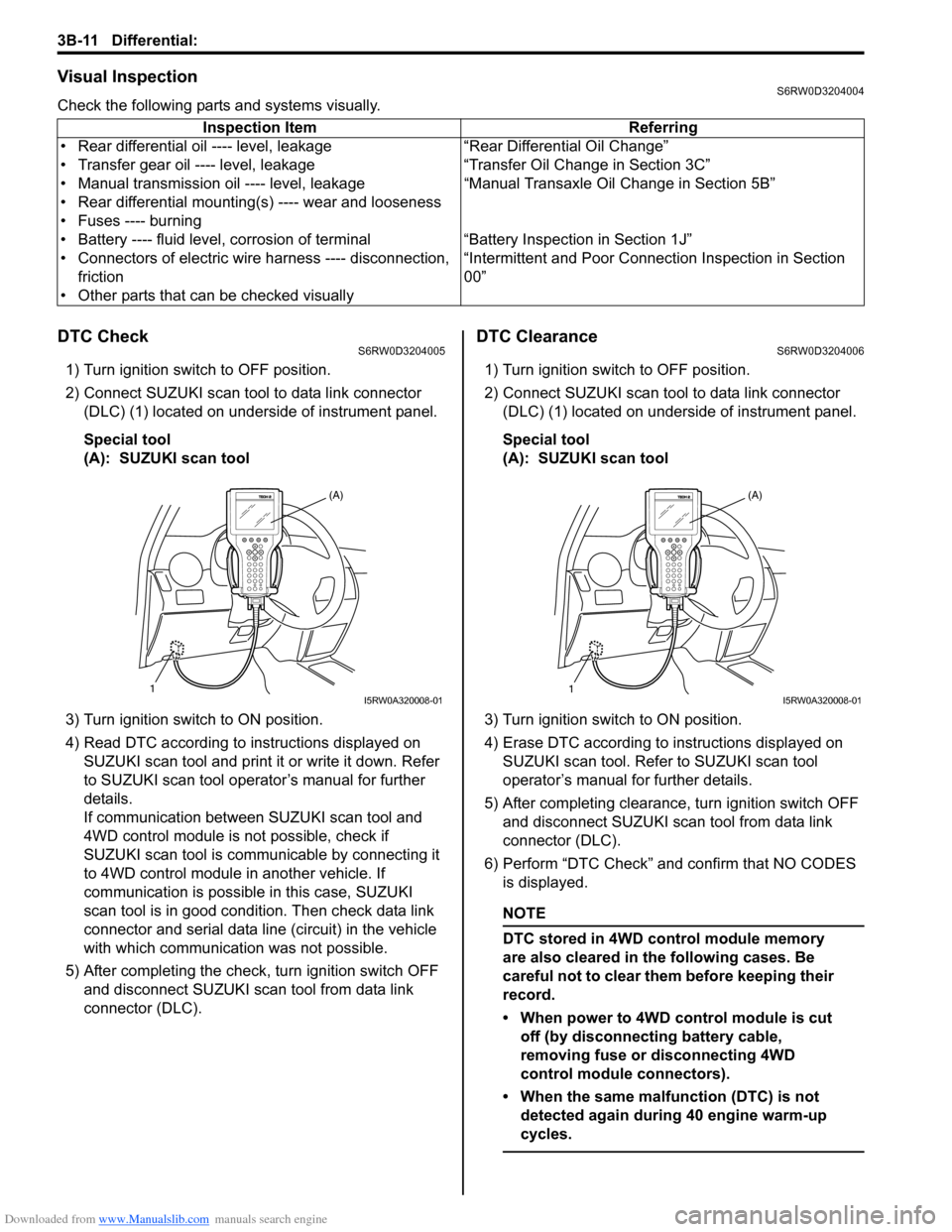
Downloaded from www.Manualslib.com manuals search engine 3B-11 Differential:
Visual InspectionS6RW0D3204004
Check the following parts and systems visually.
DTC CheckS6RW0D3204005
1) Turn ignition switch to OFF position.
2) Connect SUZUKI scan tool to data link connector
(DLC) (1) located on underside of instrument panel.
Special tool
(A): SUZUKI scan tool
3) Turn ignition switch to ON position.
4) Read DTC according to instructions displayed on
SUZUKI scan tool and print it or write it down. Refer
to SUZUKI scan tool operator’s manual for further
details.
If communication between SUZUKI scan tool and
4WD control module is not possible, check if
SUZUKI scan tool is communicable by connecting it
to 4WD control module in another vehicle. If
communication is possible in this case, SUZUKI
scan tool is in good condition. Then check data link
connector and serial data line (circuit) in the vehicle
with which communication was not possible.
5) After completing the check, turn ignition switch OFF
and disconnect SUZUKI scan tool from data link
connector (DLC).
DTC ClearanceS6RW0D3204006
1) Turn ignition switch to OFF position.
2) Connect SUZUKI scan tool to data link connector
(DLC) (1) located on underside of instrument panel.
Special tool
(A): SUZUKI scan tool
3) Turn ignition switch to ON position.
4) Erase DTC according to instructions displayed on
SUZUKI scan tool. Refer to SUZUKI scan tool
operator’s manual for further details.
5) After completing clearance, turn ignition switch OFF
and disconnect SUZUKI scan tool from data link
connector (DLC).
6) Perform “DTC Check” and confirm that NO CODES
is displayed.
NOTE
DTC stored in 4WD control module memory
are also cleared in the following cases. Be
careful not to clear them before keeping their
record.
• When power to 4WD control module is cut
off (by disconnecting battery cable,
removing fuse or disconnecting 4WD
control module connectors).
• When the same malfunction (DTC) is not
detected again during 40 engine warm-up
cycles.
Inspection Item Referring
• Rear differential oil ---- level, leakage “Rear Differential Oil Change”
• Transfer gear oil ---- level, leakage “Transfer Oil Change in Section 3C”
• Manual transmission oil ---- level, leakage “Manual Transaxle Oil Change in Section 5B”
• Rear differential mounting(s) ---- wear and looseness
• Fuses ---- burning
• Battery ---- fluid level, corrosion of terminal “Battery Inspection in Section 1J”
• Connectors of electric wire harness ---- disconnection,
friction“Intermittent and Poor Connection Inspection in Section
00”
• Other parts that can be checked visually
1(A)I5RW0A320008-011(A)I5RW0A320008-01
Page 510 of 1556

Downloaded from www.Manualslib.com manuals search engine 3B-13 Differential:
Scan Tool DataS6RW0D3204009
Scan Tool Data Definitions
Accel pedal Pos (Accelerator pedal position) (%)
Accelerator pedal opening ratio detected by signal on
CAN communication line fed from ECM.
Engine Speed (RPM)
This parameter indicates engine revolution calculated by
4WD control module.
4WD mode (2WD / AUTO / LOCK / ABS mode / Yaw
cont / ESP® req)
This parameter indicates 4WD mode according to 2WD/
4WD switch signal status detected by 4WD control
module.
4WD current (A)
This parameter indicates input current of coupling
assembly.
Battery voltage (V)
This parameter indicates battery voltage detected by
4WD control module.Coupling temp (°C, °F)
Coupling temperature detected by coupling air
temperature sensor installed in coupling assembly.
Wheel speed (F), Wheel speed (R) (km/h, mph)
Wheel speed is an ABS / ESP® control module internal
parameter. It is computed by reference pulses from the
wheel speed sensor.
F-R Wheel speed diff (Front-rear wheel speed
differential) (rpm)
This parameter indicates rotation difference between
front wheel and rear wheel detected by 4WD control
module.
4WD duty (%)
This parameter indicates operation rate of coupling
assembly. Scan tool data Vehicle conditionNormal condition / reference
values
�) Accel pedal PosIgnition switch ON after
warmed up engineAccelerator pedal released 0 – 5%
Accelerator pedal depressed
fully90 – 100%
�) Engine speed At engine idle speed Engine idle speed is display
�) 4WD mode2WD/4WD switch selected to 2WD position 2WD
2WD/4WD switch selected to AUTO position AUTO
2WD/4WD switch selected to LOCK position LOCK
ABS operating ABS mode
Ignition switch ON and engine stop Relay off
Stability control operating Yaw cont
ESP® operating ESP® mode
�) 4WD current Engine running 0 – 200 mA
�) Battery voltage At engine idle speed 10 – 14 V
�) Coupling temp Engine running –40 °C – 100 °C (–40 °F – 212 °F)
�) Wheel speed (F) Vehicle stop 0 km/h, 0 MPH
�) Wheel speed (R) Vehicle stop 0 km/h, 0 MPH
�) F-R Wheel speed
DiffVehicle stop 0 rpm
�) 4WD dutyIgnition switch ON and 2WD/4WD switch selected to
2WD position0%
Page 616 of 1556
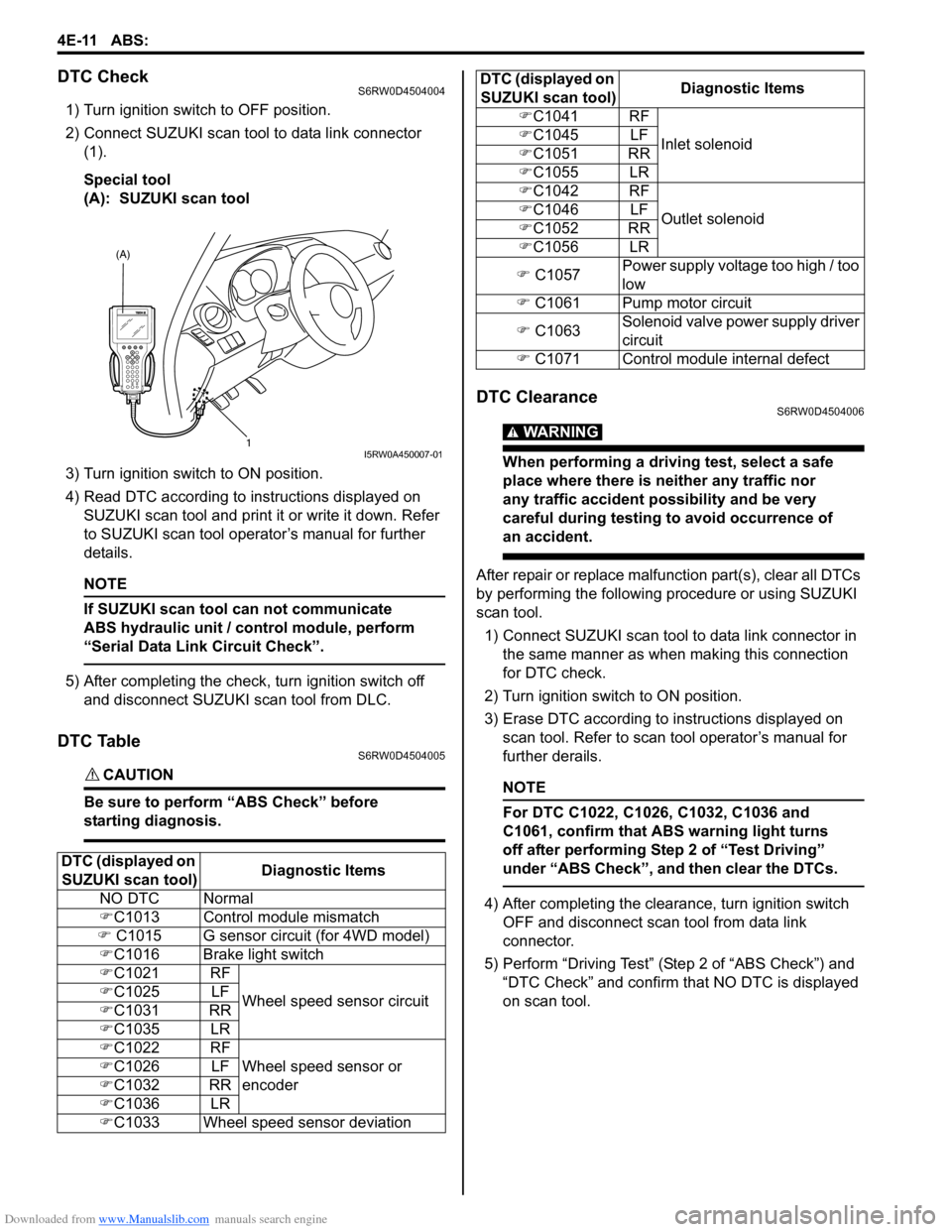
Downloaded from www.Manualslib.com manuals search engine 4E-11 ABS:
DTC CheckS6RW0D4504004
1) Turn ignition switch to OFF position.
2) Connect SUZUKI scan tool to data link connector
(1).
Special tool
(A): SUZUKI scan tool
3) Turn ignition switch to ON position.
4) Read DTC according to instructions displayed on
SUZUKI scan tool and print it or write it down. Refer
to SUZUKI scan tool operator’s manual for further
details.
NOTE
If SUZUKI scan tool can not communicate
ABS hydraulic unit / control module, perform
“Serial Data Link Circuit Check”.
5) After completing the check, turn ignition switch off
and disconnect SUZUKI scan tool from DLC.
DTC TableS6RW0D4504005
CAUTION!
Be sure to perform “ABS Check” before
starting diagnosis.
DTC ClearanceS6RW0D4504006
WARNING!
When performing a driving test, select a safe
place where there is neither any traffic nor
any traffic accident possibility and be very
careful during testing to avoid occurrence of
an accident.
After repair or replace malfunction part(s), clear all DTCs
by performing the following procedure or using SUZUKI
scan tool.
1) Connect SUZUKI scan tool to data link connector in
the same manner as when making this connection
for DTC check.
2) Turn ignition switch to ON position.
3) Erase DTC according to instructions displayed on
scan tool. Refer to scan tool operator’s manual for
further derails.
NOTE
For DTC C1022, C1026, C1032, C1036 and
C1061, confirm that ABS warning light turns
off after performing Step 2 of “Test Driving”
under “ABS Check”, and then clear the DTCs.
4) After completing the clearance, turn ignition switch
OFF and disconnect scan tool from data link
connector.
5) Perform “Driving Test” (Step 2 of “ABS Check”) and
“DTC Check” and confirm that NO DTC is displayed
on scan tool. DTC (displayed on
SUZUKI scan tool)Diagnostic Items
NO DTC Normal
�)C1013 Control module mismatch
�) C1015 G sensor circuit (for 4WD model)
�)C1016 Brake light switch
�)C1021 RF
Wheel speed sensor circuit �)C1025 LF
�)C1031 RR
�)C1035 LR
�)C1022 RF
Wheel speed sensor or
encoder �)C1026 LF
�)C1032 RR
�)C1036 LR
�)C1033 Wheel speed sensor deviation
(A)
1
I5RW0A450007-01
�)C1041 RF
Inlet solenoid �)C1045 LF
�)C1051 RR
�)C1055 LR
�)C1042 RF
Outlet solenoid �)C1046 LF
�)C1052 RR
�)C1056 LR
�) C1057Power supply voltage too high / too
low
�) C1061 Pump motor circuit
�) C1063Solenoid valve power supply driver
circuit
�) C1071 Control module internal defect DTC (displayed on
SUZUKI scan tool)Diagnostic Items
Page 617 of 1556
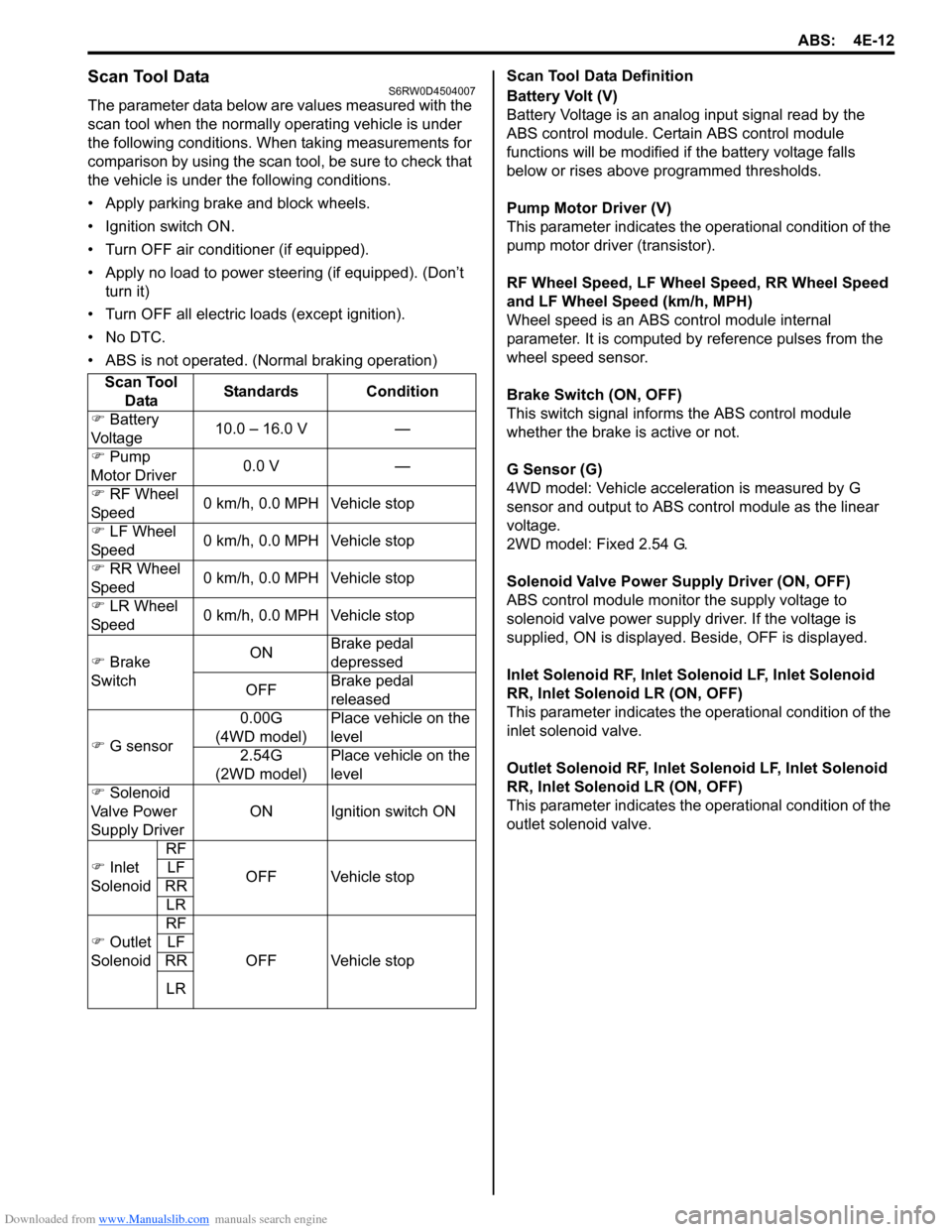
Downloaded from www.Manualslib.com manuals search engine ABS: 4E-12
Scan Tool DataS6RW0D4504007
The parameter data below are values measured with the
scan tool when the normally operating vehicle is under
the following conditions. When taking measurements for
comparison by using the scan tool, be sure to check that
the vehicle is under the following conditions.
• Apply parking brake and block wheels.
• Ignition switch ON.
• Turn OFF air conditioner (if equipped).
• Apply no load to power steering (if equipped). (Don’t
turn it)
• Turn OFF all electric loads (except ignition).
• No DTC.
• ABS is not operated. (Normal braking operation)Scan Tool Data Definition
Battery Volt (V)
Battery Voltage is an analog input signal read by the
ABS control module. Certain ABS control module
functions will be modified if the battery voltage falls
below or rises above programmed thresholds.
Pump Motor Driver (V)
This parameter indicates the operational condition of the
pump motor driver (transistor).
RF Wheel Speed, LF Wheel Speed, RR Wheel Speed
and LF Wheel Speed (km/h, MPH)
Wheel speed is an ABS control module internal
parameter. It is computed by reference pulses from the
wheel speed sensor.
Brake Switch (ON, OFF)
This switch signal informs the ABS control module
whether the brake is active or not.
G Sensor (G)
4WD model: Vehicle acceleration is measured by G
sensor and output to ABS control module as the linear
voltage.
2WD model: Fixed 2.54 G.
Solenoid Valve Power Supply Driver (ON, OFF)
ABS control module monitor the supply voltage to
solenoid valve power supply driver. If the voltage is
supplied, ON is displayed. Beside, OFF is displayed.
Inlet Solenoid RF, Inlet Solenoid LF, Inlet Solenoid
RR, Inlet Solenoid LR (ON, OFF)
This parameter indicates the operational condition of the
inlet solenoid valve.
Outlet Solenoid RF, Inlet Solenoid LF, Inlet Solenoid
RR, Inlet Solenoid LR (ON, OFF)
This parameter indicates the operational condition of the
outlet solenoid valve. Scan Tool
DataStandards Condition
�) Battery
Voltage10.0 – 16.0 V —
�) Pump
Motor Driver0.0 V —
�) RF Wheel
Speed0 km/h, 0.0 MPH Vehicle stop
�) LF Wheel
Speed0 km/h, 0.0 MPH Vehicle stop
�) RR Wheel
Speed0 km/h, 0.0 MPH Vehicle stop
�) LR Wheel
Speed0 km/h, 0.0 MPH Vehicle stop
�) Brake
SwitchONBrake pedal
depressed
OFFBrake pedal
released
�) G sensor0.00G
(4WD model)Place vehicle on the
level
2.54G
(2WD model)Place vehicle on the
level
�) Solenoid
Valve Power
Supply DriverON Ignition switch ON
�) Inlet
SolenoidRF
OFF Vehicle stop LF
RR
LR
�) Outlet
SolenoidRF
OFF Vehicle stop LF
RR
LR
Page 649 of 1556
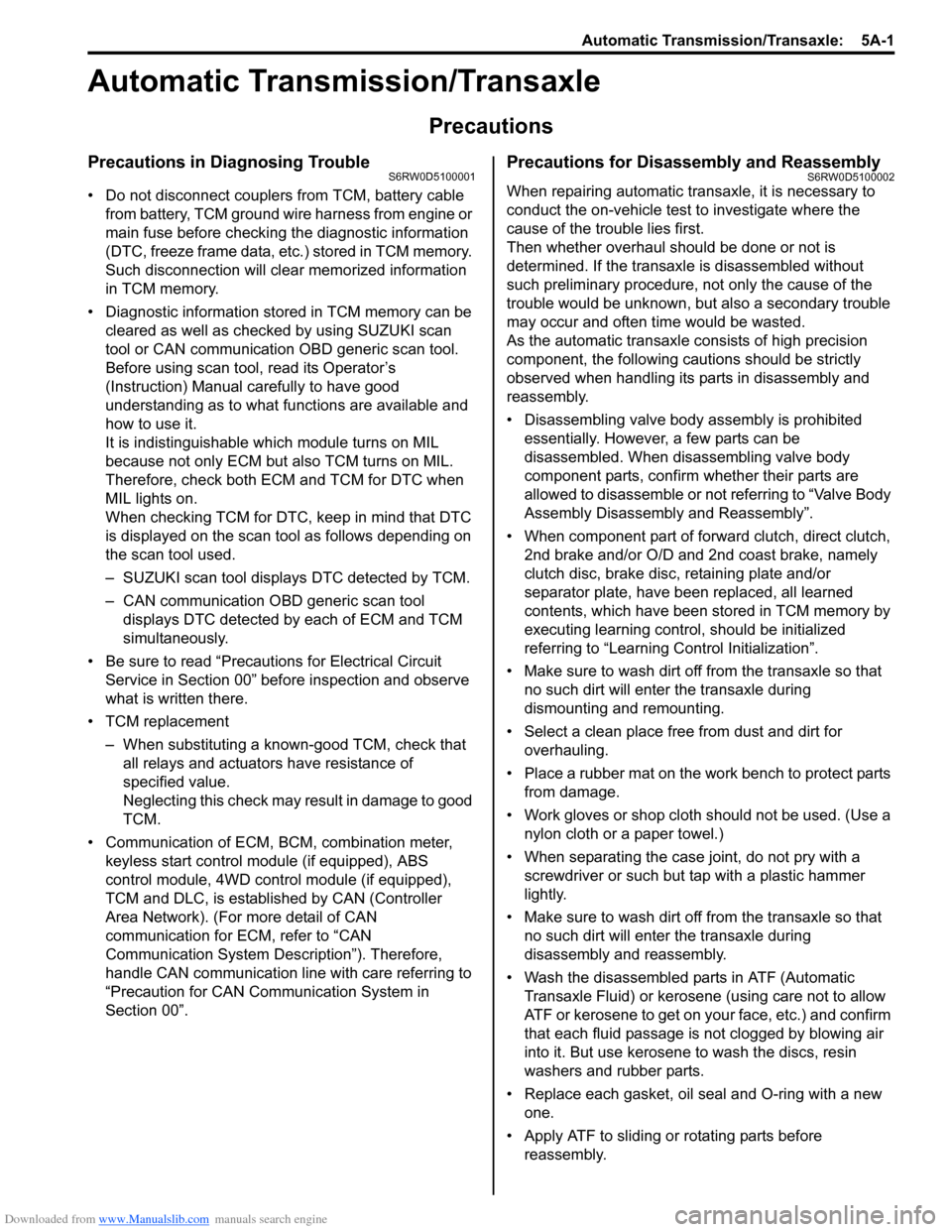
Downloaded from www.Manualslib.com manuals search engine Automatic Transmission/Transaxle: 5A-1
Transmission / Transaxle
Automatic Transmission/Transaxle
Precautions
Precautions in Diagnosing TroubleS6RW0D5100001
• Do not disconnect couplers from TCM, battery cable
from battery, TCM ground wire harness from engine or
main fuse before checking the diagnostic information
(DTC, freeze frame data, etc.) stored in TCM memory.
Such disconnection will clear memorized information
in TCM memory.
• Diagnostic information stored in TCM memory can be
cleared as well as checked by using SUZUKI scan
tool or CAN communication OBD generic scan tool.
Before using scan tool, read its Operator’s
(Instruction) Manual carefully to have good
understanding as to what functions are available and
how to use it.
It is indistinguishable which module turns on MIL
because not only ECM but also TCM turns on MIL.
Therefore, check both ECM and TCM for DTC when
MIL lights on.
When checking TCM for DTC, keep in mind that DTC
is displayed on the scan tool as follows depending on
the scan tool used.
– SUZUKI scan tool displays DTC detected by TCM.
– CAN communication OBD generic scan tool
displays DTC detected by each of ECM and TCM
simultaneously.
• Be sure to read “Precautions for Electrical Circuit
Service in Section 00” before inspection and observe
what is written there.
• TCM replacement
– When substituting a known-good TCM, check that
all relays and actuators have resistance of
specified value.
Neglecting this check may result in damage to good
TCM.
• Communication of ECM, BCM, combination meter,
keyless start control module (if equipped), ABS
control module, 4WD control module (if equipped),
TCM and DLC, is established by CAN (Controller
Area Network). (For more detail of CAN
communication for ECM, refer to “CAN
Communication System Description”). Therefore,
handle CAN communication line with care referring to
“Precaution for CAN Communication System in
Section 00”.
Precautions for Disassembly and ReassemblyS6RW0D5100002
When repairing automatic transaxle, it is necessary to
conduct the on-vehicle test to investigate where the
cause of the trouble lies first.
Then whether overhaul should be done or not is
determined. If the transaxle is disassembled without
such preliminary procedure, not only the cause of the
trouble would be unknown, but also a secondary trouble
may occur and often time would be wasted.
As the automatic transaxle consists of high precision
component, the following cautions should be strictly
observed when handling its parts in disassembly and
reassembly.
• Disassembling valve body assembly is prohibited
essentially. However, a few parts can be
disassembled. When disassembling valve body
component parts, confirm whether their parts are
allowed to disassemble or not referring to “Valve Body
Assembly Disassembly and Reassembly”.
• When component part of forward clutch, direct clutch,
2nd brake and/or O/D and 2nd coast brake, namely
clutch disc, brake disc, retaining plate and/or
separator plate, have been replaced, all learned
contents, which have been stored in TCM memory by
executing learning control, should be initialized
referring to “Learning Control Initialization”.
• Make sure to wash dirt off from the transaxle so that
no such dirt will enter the transaxle during
dismounting and remounting.
• Select a clean place free from dust and dirt for
overhauling.
• Place a rubber mat on the work bench to protect parts
from damage.
• Work gloves or shop cloth should not be used. (Use a
nylon cloth or a paper towel.)
• When separating the case joint, do not pry with a
screwdriver or such but tap with a plastic hammer
lightly.
• Make sure to wash dirt off from the transaxle so that
no such dirt will enter the transaxle during
disassembly and reassembly.
• Wash the disassembled parts in ATF (Automatic
Transaxle Fluid) or kerosene (using care not to allow
ATF or kerosene to get on your face, etc.) and confirm
that each fluid passage is not clogged by blowing air
into it. But use kerosene to wash the discs, resin
washers and rubber parts.
• Replace each gasket, oil seal and O-ring with a new
one.
• Apply ATF to sliding or rotating parts before
reassembly.
Page 669 of 1556
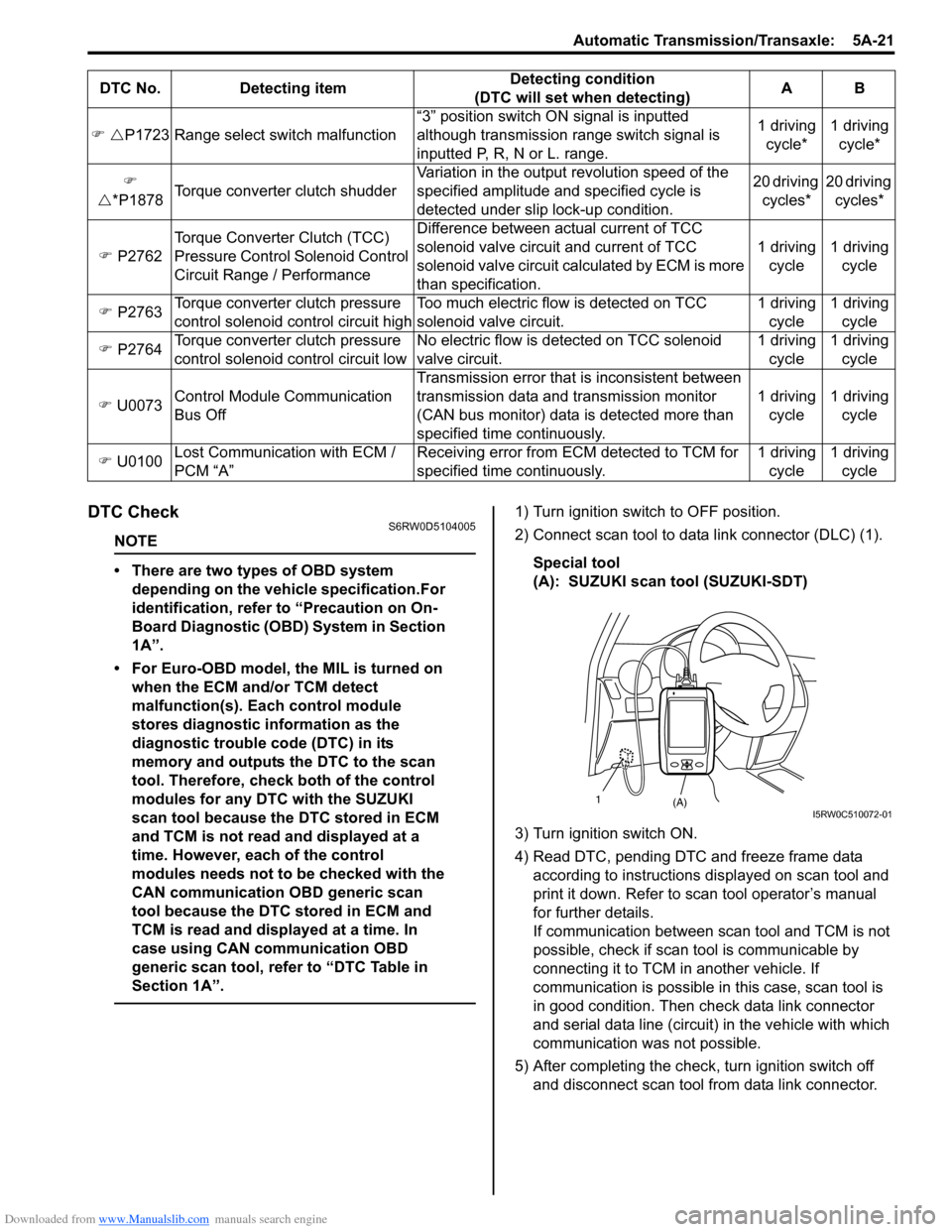
Downloaded from www.Manualslib.com manuals search engine Automatic Transmission/Transaxle: 5A-21
DTC CheckS6RW0D5104005
NOTE
• There are two types of OBD system
depending on the vehicle specification.For
identification, refer to “Precaution on On-
Board Diagnostic (OBD) System in Section
1A”.
• For Euro-OBD model, the MIL is turned on
when the ECM and/or TCM detect
malfunction(s). Each control module
stores diagnostic information as the
diagnostic trouble code (DTC) in its
memory and outputs the DTC to the scan
tool. Therefore, check both of the control
modules for any DTC with the SUZUKI
scan tool because the DTC stored in ECM
and TCM is not read and displayed at a
time. However, each of the control
modules needs not to be checked with the
CAN communication OBD generic scan
tool because the DTC stored in ECM and
TCM is read and displayed at a time. In
case using CAN communication OBD
generic scan tool, refer to “DTC Table in
Section 1A”.
1) Turn ignition switch to OFF position.
2) Connect scan tool to data link connector (DLC) (1).
Special tool
(A): SUZUKI scan tool (SUZUKI-SDT)
3) Turn ignition switch ON.
4) Read DTC, pending DTC and freeze frame data
according to instructions displayed on scan tool and
print it down. Refer to scan tool operator’s manual
for further details.
If communication between scan tool and TCM is not
possible, check if scan tool is communicable by
connecting it to TCM in another vehicle. If
communication is possible in this case, scan tool is
in good condition. Then check data link connector
and serial data line (circuit) in the vehicle with which
communication was not possible.
5) After completing the check, turn ignition switch off
and disconnect scan tool from data link connector. �) �UP1723 Range select switch malfunction“3” position switch ON signal is inputted
although transmission range switch signal is
inputted P, R, N or L. range.1 driving
cycle*1 driving
cycle*
�)
�U*P1878Torque converter clutch shudderVariation in the output revolution speed of the
specified amplitude and specified cycle is
detected under slip lock-up condition.20 driving
cycles*20 driving
cycles*
�) P2762Torque Converter Clutch (TCC)
Pressure Control Solenoid Control
Circuit Range / PerformanceDifference between actual current of TCC
solenoid valve circuit and current of TCC
solenoid valve circuit calculated by ECM is more
than specification.1 driving
cycle1 driving
cycle
�) P2763Torque converter clutch pressure
control solenoid control circuit highToo much electric flow is detected on TCC
solenoid valve circuit.1 driving
cycle1 driving
cycle
�) P2764Torque converter clutch pressure
control solenoid control circuit lowNo electric flow is detected on TCC solenoid
valve circuit.1 driving
cycle1 driving
cycle
�) U0073Control Module Communication
Bus OffTransmission error that is inconsistent between
transmission data and transmission monitor
(CAN bus monitor) data is detected more than
specified time continuously.1 driving
cycle1 driving
cycle
�) U0100Lost Communication with ECM /
PCM “A”Receiving error from ECM detected to TCM for
specified time continuously.1 driving
cycle1 driving
cycle DTC No. Detecting itemDetecting condition
(DTC will set when detecting)AB
(A) 1I5RW0C510072-01
Page 670 of 1556
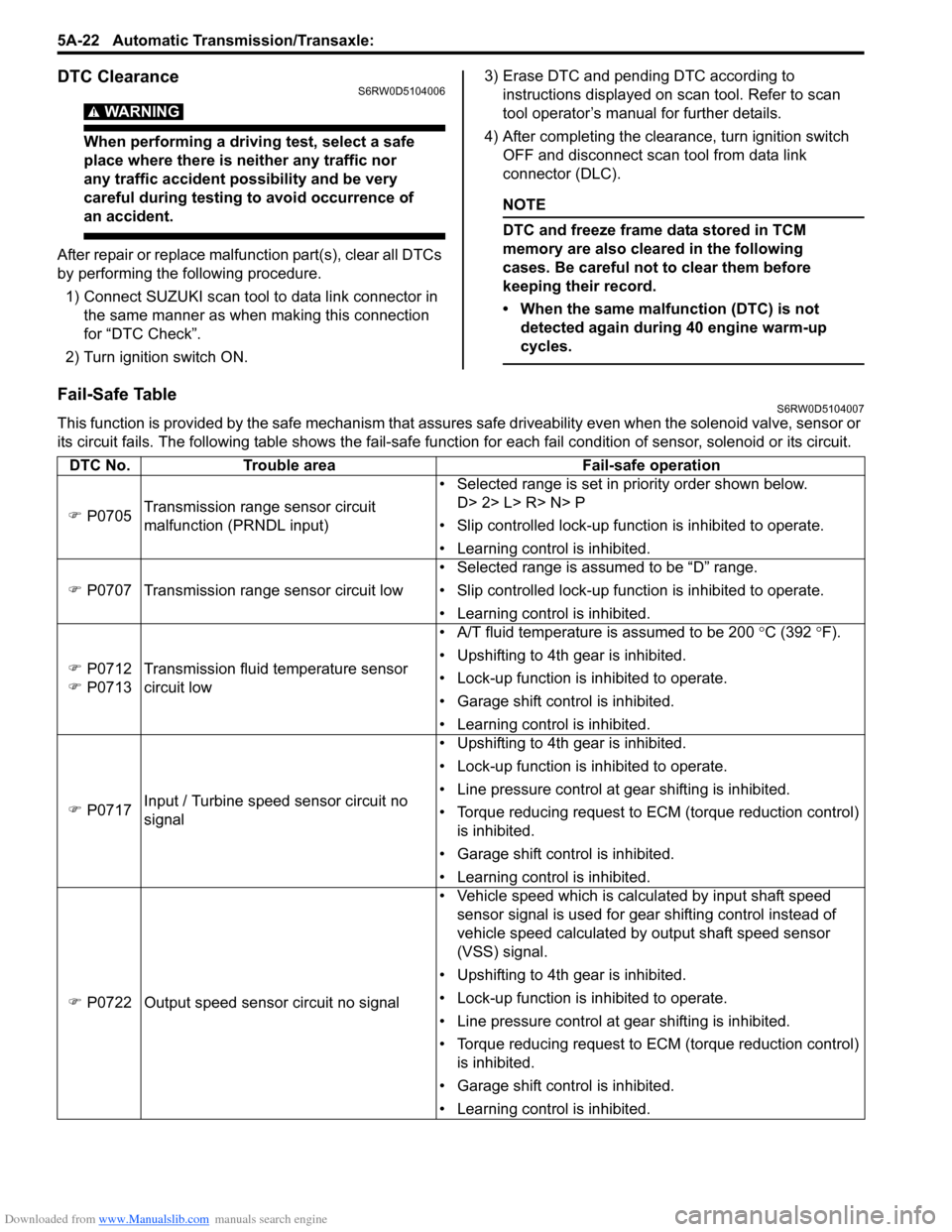
Downloaded from www.Manualslib.com manuals search engine 5A-22 Automatic Transmission/Transaxle:
DTC ClearanceS6RW0D5104006
WARNING!
When performing a driving test, select a safe
place where there is neither any traffic nor
any traffic accident possibility and be very
careful during testing to avoid occurrence of
an accident.
After repair or replace malfunction part(s), clear all DTCs
by performing the following procedure.
1) Connect SUZUKI scan tool to data link connector in
the same manner as when making this connection
for “DTC Check”.
2) Turn ignition switch ON.3) Erase DTC and pending DTC according to
instructions displayed on scan tool. Refer to scan
tool operator’s manual for further details.
4) After completing the clearance, turn ignition switch
OFF and disconnect scan tool from data link
connector (DLC).
NOTE
DTC and freeze frame data stored in TCM
memory are also cleared in the following
cases. Be careful not to clear them before
keeping their record.
• When the same malfunction (DTC) is not
detected again during 40 engine warm-up
cycles.
Fail-Safe TableS6RW0D5104007
This function is provided by the safe mechanism that assures safe driveability even when the solenoid valve, sensor or
its circuit fails. The following table shows the fail-safe function for each fail condition of sensor, solenoid or its circuit.
DTC No. Trouble area Fail-safe operation
�) P0705Transmission range sensor circuit
malfunction (PRNDL input)• Selected range is set in priority order shown below.
D> 2> L> R> N> P
• Slip controlled lock-up function is inhibited to operate.
• Learning control is inhibited.
�) P0707 Transmission range sensor circuit low• Selected range is assumed to be “D” range.
• Slip controlled lock-up function is inhibited to operate.
• Learning control is inhibited.
�) P0712
�) P0713Transmission fluid temperature sensor
circuit low• A/T fluid temperature is assumed to be 200 °C (392 °F).
• Upshifting to 4th gear is inhibited.
• Lock-up function is inhibited to operate.
• Garage shift control is inhibited.
• Learning control is inhibited.
�) P0717Input / Turbine speed sensor circuit no
signal• Upshifting to 4th gear is inhibited.
• Lock-up function is inhibited to operate.
• Line pressure control at gear shifting is inhibited.
• Torque reducing request to ECM (torque reduction control)
is inhibited.
• Garage shift control is inhibited.
• Learning control is inhibited.
�) P0722 Output speed sensor circuit no signal• Vehicle speed which is calculated by input shaft speed
sensor signal is used for gear shifting control instead of
vehicle speed calculated by output shaft speed sensor
(VSS) signal.
• Upshifting to 4th gear is inhibited.
• Lock-up function is inhibited to operate.
• Line pressure control at gear shifting is inhibited.
• Torque reducing request to ECM (torque reduction control)
is inhibited.
• Garage shift control is inhibited.
• Learning control is inhibited.
Page 672 of 1556

Downloaded from www.Manualslib.com manuals search engine 5A-24 Automatic Transmission/Transaxle:
Scan Tool DataS6RW0D5104008
As the data values given in the following table are standard values estimated on the basis of values obtained from the
normally operating vehicles by using a scan tool, use them as reference values. Even when the vehicle is in good
condition, there may be cases where the checked value does not fall within each specified data range. Therefore,
judgment as abnormal should not be made by checking with these data alone.
Also, condition in the following table that can be checked by the scan tool are those detected by TCM and output from
TCM as commands and there may be cases where the automatic transaxle or actuator is not operating (in the
condition) as indicated by the scan tool.
NOTE
The following scan tool data related to automatic transaxle can be checked only by communicating
with TCM.
�) U0100TCM lost communication with ECM
(Reception error)• Throttle opening used for line pressure control is assumed
to be 100%.
• Throttle opening used for gear shifting control is assumed
to be 0%.
• Engine revolution is assumed to be 0 RPM.
• After 15 minutes pass from detecting malfunction, engine
coolant temperature is assumed to be 90 °C (194 °F).
• Lock-up function is inhibited to operate.
• Slip controlled lock-up function is inhibited to operate.
• Line pressure control at gear shifting is inhibited.
• Torque reducing request to ECM (torque reduction control)
is inhibited.
• Upshifting to 4th gear is inhibited.
• Garage shift control is inhibited.
• Learning control is inhibited. DTC No. Trouble area Fail-safe operation
Scan tool data Vehicle conditionNormal condition / reference
values
�) GEAR POSITION Ignition switch ONSelect lever is in “P” position P or N
Select lever is in “R” position R
Select lever is in “N” position P or N
Select lever is in “D” position 1
Select lever is in “3” position 1
Select lever is in “2” position 1
Select lever is in “L” position 1
�) ENGINE SPEED At engine idle speed Engine idle speed is displayed
�) INPUT SHAFT
REVOLUTIONIgnition switch ON and engine stop 0 RPM
At 60 km/h (37.5 mile/h) constant speed, 20% or less
throttle opening and 3rd gear (“3” range)2300 RPM
(displayed in increments of 0.25 rpm)
�) OUTPUT SHAFT
REVOLUTIONAt vehicle stop 0 RPM
At 60 km/h (37.5 mile/h) constant speed, 20% or less
throttle opening and 3rd gear (“3” range)2300 RPM
(displayed in increments of 0.25 rpm)
�) BATTERY
VOLTAGEIgnition switch ON and engine stopBattery voltage is displayed
(8 – 16 V)
�) AT F
TEMPERATUREAfter driving at 60 km/h (37.5 mile/h) for 15 minutes or
more, and A/T fluid temperature around sensor
reaches 70 – 80 °C (158 – 176 °F)70 – 80 °C (158 – 176 °F)
�) SHIFT SOLENOID-
A COMMANDAt vehicle stop ON
At 60 km/h (37.5 mile/h) constant speed, 20% or less
throttle opening and 3rd gear (“3” range)OFF
�) SHIFT SOLENOID-
A MONITORAt vehicle stop ON
At 60 km/h (37.5 mile/h) constant speed, 20% or less
throttle opening and 3rd gear (“3” range)OFF
Page 673 of 1556
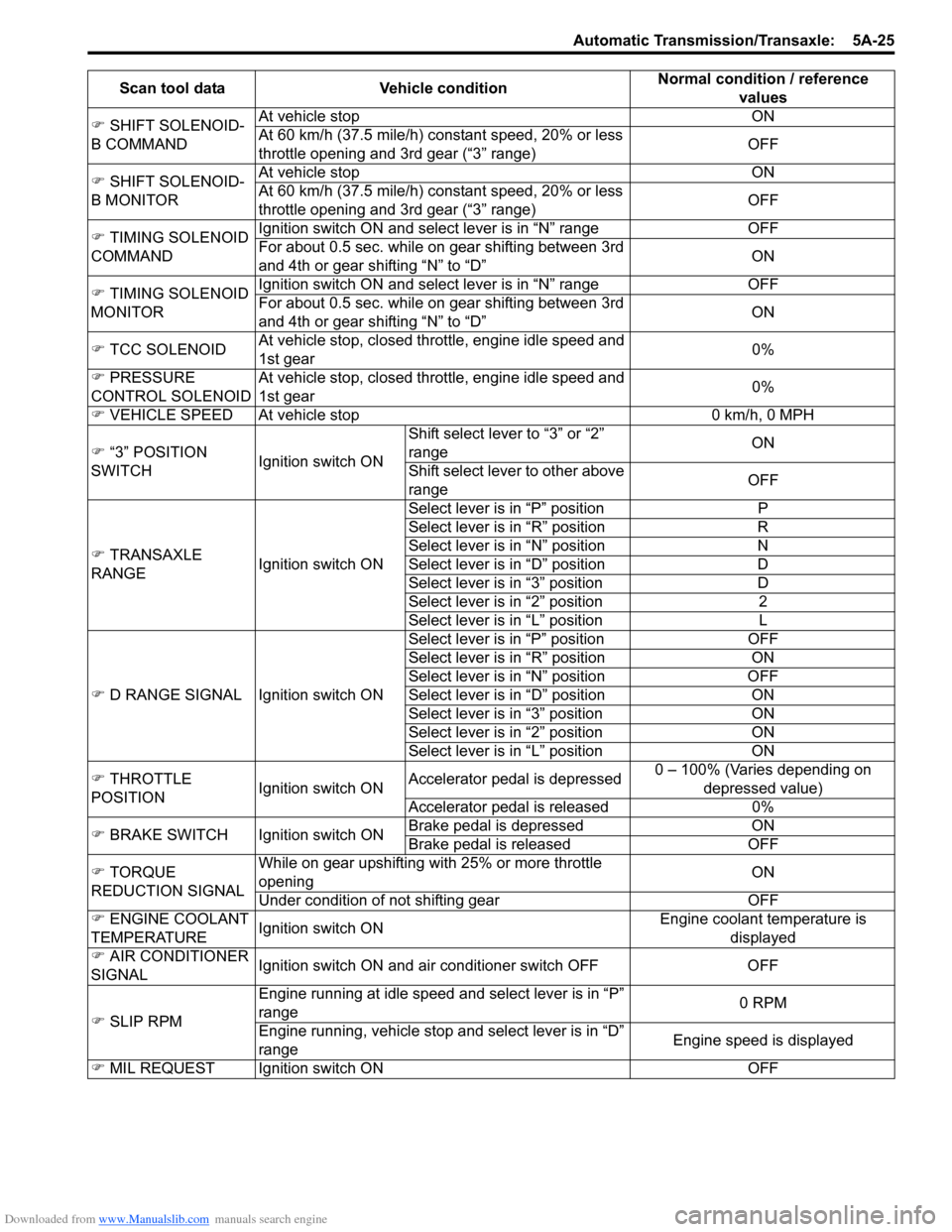
Downloaded from www.Manualslib.com manuals search engine Automatic Transmission/Transaxle: 5A-25
�) SHIFT SOLENOID-
B COMMANDAt vehicle stop ON
At 60 km/h (37.5 mile/h) constant speed, 20% or less
throttle opening and 3rd gear (“3” range)OFF
�) SHIFT SOLENOID-
B MONITORAt vehicle stop ON
At 60 km/h (37.5 mile/h) constant speed, 20% or less
throttle opening and 3rd gear (“3” range)OFF
�) TIMING SOLENOID
COMMANDIgnition switch ON and select lever is in “N” range OFF
For about 0.5 sec. while on gear shifting between 3rd
and 4th or gear shifting “N” to “D”ON
�) TIMING SOLENOID
MONITORIgnition switch ON and select lever is in “N” range OFF
For about 0.5 sec. while on gear shifting between 3rd
and 4th or gear shifting “N” to “D”ON
�) TCC SOLENOID At vehicle stop, closed throttle, engine idle speed and
1st gear0%
�) PRESSURE
CONTROL SOLENOIDAt vehicle stop, closed throttle, engine idle speed and
1st gear0%
�) VEHICLE SPEED At vehicle stop 0 km/h, 0 MPH
�) “3” POSITION
SWITCHIgnition switch ONShift select lever to “3” or “2”
rangeON
Shift select lever to other above
rangeOFF
�) TRANSAXLE
RANGEIgnition switch ONSelect lever is in “P” position P
Select lever is in “R” position R
Select lever is in “N” position N
Select lever is in “D” position D
Select lever is in “3” position D
Select lever is in “2” position 2
Select lever is in “L” position L
�) D RANGE SIGNAL Ignition switch ONSelect lever is in “P” position OFF
Select lever is in “R” position ON
Select lever is in “N” position OFF
Select lever is in “D” position ON
Select lever is in “3” position ON
Select lever is in “2” position ON
Select lever is in “L” position ON
�) THROTTLE
POSITIONIgnition switch ONAccelerator pedal is depressed0 – 100% (Varies depending on
depressed value)
Accelerator pedal is released 0%
�) BRAKE SWITCH Ignition switch ONBrake pedal is depressed ON
Brake pedal is released OFF
�) TORQUE
REDUCTION SIGNALWhile on gear upshifting with 25% or more throttle
openingON
Under condition of not shifting gear OFF
�) ENGINE COOLANT
TEMPERATUREIgnition switch ONEngine coolant temperature is
displayed
�) AIR CONDITIONER
SIGNALIgnition switch ON and air conditioner switch OFF OFF
�) SLIP RPMEngine running at idle speed and select lever is in “P”
range0 RPM
Engine running, vehicle stop and select lever is in “D”
rangeEngine speed is displayed
�) MIL REQUEST Ignition switch ON OFFScan tool data Vehicle conditionNormal condition / reference
values
Page 691 of 1556

Downloaded from www.Manualslib.com manuals search engine Automatic Transmission/Transaxle: 5A-43
DTC Detecting Condition and Trouble Area
DTC Confirmation Procedure
1) Connect scan tool to DLC with ignition switch OFF.
2) Clear DTCs in TCM memory by using scan tool.
3) Start engine and shift select lever to “D” range.
4) Keep engine running at idle speed for 25 seconds or more.
5) Stop vehicle and check DTC.
DTC TroubleshootingDTC detecting condition Trouble area
Multiple or more signals are inputted simultaneously for 10
seconds.• Select cable maladjusted
• Transmission range sensor maladjusted
• Transmission range sensor or its circuit malfunction
•TCM
Step Action Yes No
1Was “A/T System Check” performed?Go to Step 2. Go to “A/T System
Check”.
2Do you have SUZUKI scan tool?Go to Step 3. Go to Step 4.
3Check transmission range sensor circuit for operation
Check by using SUZUKI scan tool:
1) Connect SUZUKI scan tool to DLC with ignition switch
OFF.
2) Turn ignition switch ON and check transmission range
signal (“P”, “R”, “N”, “D”, “2” or “L”) on display when
shifting select lever to each range.
Is applicable range indicated?Intermittent trouble.
Check for intermittent
referring to “Intermittent
and Poor Connection
Inspection in Section
00”.Go to Step 5.
4Check transmission range sensor circuit for operation
Check by not using SUZUKI scan tool:
1) Turn ignition switch ON.
2) Check voltage at terminals “C07-1”, “C07-7”, “C07-8”,
“C07-18”, “C07-19” and “C07-20” respectively with
select lever shifted to each range.
Taking terminal “C07-19” as an example, is battery
voltage indicated only when select lever is shifted to “2”
range and 0 V for other ranges as shown in the following
table.
Check voltage at other terminals likewise, referring to the
following table.
Are check results satisfactory?Intermittent trouble.
Check for intermittent
referring to “Intermittent
and Poor Connection
Inspection in Section
00”.Go to Step 5.
5 1) Check select cable for adjustment referring to “Select
Cable Adjustment”.
Is it adjusted correctly?Go to Step 6. Adjust.
6Check transmission range sensor for installation
position
1) Shift select lever to “N” range.
2) Check that “N” reference line on sensor and needle
direction shaped on lock washer are aligned.
Are they aligned?Go to Step 7. Adjust.